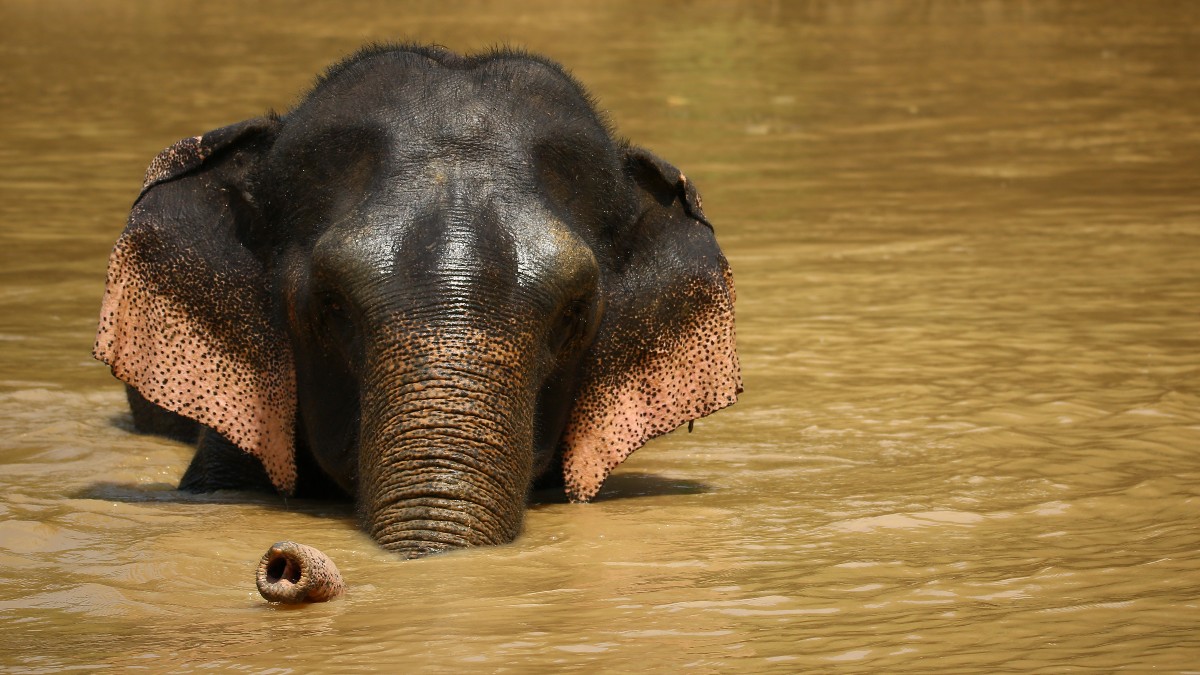It is well known that elephants love water. Despite their size, they are also excellent swimmers! If you have ever watched an elephant crossing a river or enjoying a bath in it, you might have noticed something fascinating—they often submerge their entire bodies, leaving only the tips of their trunks above water to breathe. This allows them to use their trunks in the way that humans use snorkels, so that they can continue to breathe even when they are fully under water. Now that surely is a remarkable natural trait that sets them apart from other animals!
While elephants are strong swimmers, they actually prefer to walk on the riverbed, keeping their entire bodies, other than the end of their trunks, submerged. The sight resembles what periscopes for submarines look like, except that these are actual nostrils that are helping the large mammal breathe!
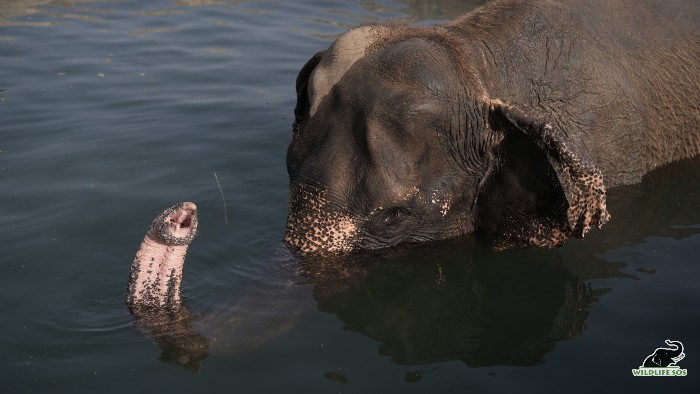
The trunk does for elephants underwater what the pipe of a snorkel does for humans, but there is a significant difference in breathing between elephants and humans. Water pressure increases as one goes deeper into water, which is why snorkels for humans are limited to about 30-40 cm in length. Any longer than that would make the pressure too much for the human lungs to handle. Elephants, however, can dive deeper and still breathe without a problem, thanks to a unique adaptation they have. The elephants’ ‘pipe’ (their trunk) is connected directly to their lungs. Unlike humans and other mammals that possess lungs, these gentle giants lack a space called pleural space that commonly exists between lungs and the chest wall.
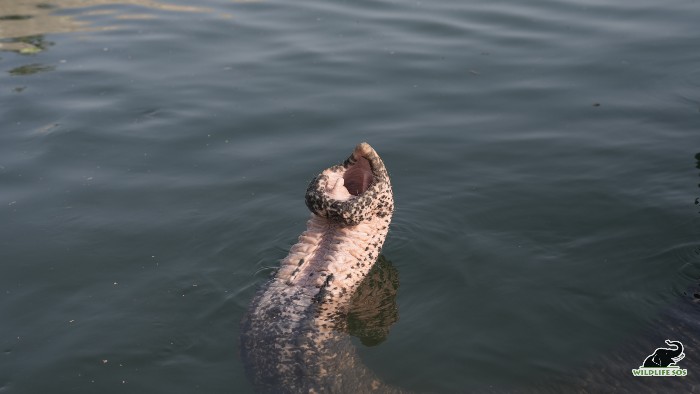
Instead of the pleural space, elephants have dense connective tissue in this area. This feature gifts them the power to withstand the pressure differences at depths that snorkelling for humans would not be able to support at all.
Interesting, isn’t it? To understand more about this evolutionary advantage in elephants, read on!
What is a Pleural Space and How does it Help?
The pleural space is formed by two layers of tissue that protect and cushion the lungs of mammals. The outer layer, known as the parietal pleura, lines the inside of the chest wall, while the inner layer, called the visceral pleura, tightly covers the lungs and follows its contours. Between these two layers is a small space filled with fluid, the pleural cavity, which helps the layers glide smoothly over each other while breathing.

For mammals, including our kind, the act of breathing is largely dependent on the movement of these pleural membranes. As the chest expands through muscular action, the parietal pleura (attached to the chest wall) moves outward, while the visceral pleura remains stationary as it is fixed to the lungs. This expansion creates a vacuum-like effect in the pleural cavity, allowing air to be drawn into the lungs.
In elephants, however, this process works differently because they lack pleural space altogether. Instead of a fluid-filled cavity, elephants have dense and loose connective tissues that fill the area, directly attaching their lungs to the ribcage and diaphragm. Without a pleural cavity, elephants rely on the muscular movements of their chest to breathe. Since their lungs are anchored right on to the chest wall, they expand and contract only through the chest muscles, which, for other mammals, is made possible via the pleural space.
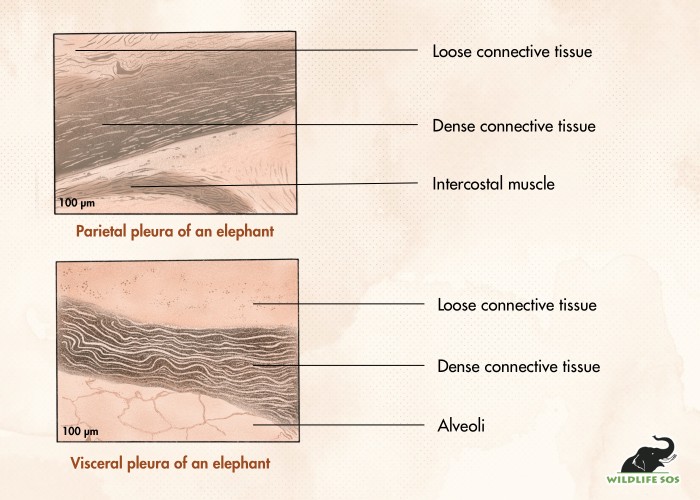
This unique adaptation is what allows elephants to withstand immense water pressure when submerged. While this is a remarkable advantage, lungs being connected to the protective wall of the chest does bear with it a disclaimer: if an elephant experiences restraint or weight on its chest, it could suffocate, as such obstructions can restrict the movement of the chest and diaphragm that grants them the ability to breathe.
What Happens when Humans Snorkel in Deep Water?
In mammals with lungs, the pleural membrane is very thin, and it rests on the endothoracic fascia, a layer of connective tissue that connects the parietal pleura to the chest wall. This pleural membrane consists of a layer of cells over tiny blood vessels known as microvessels. These microvessels produce a fluid called transudate, which is a thin, watery liquid with low protein and cell content. Transudate moves into small spaces called lacunae and is then released into the pleural space, providing lubrication so that the two pleural layers can slide smoothly over each other during breathing.
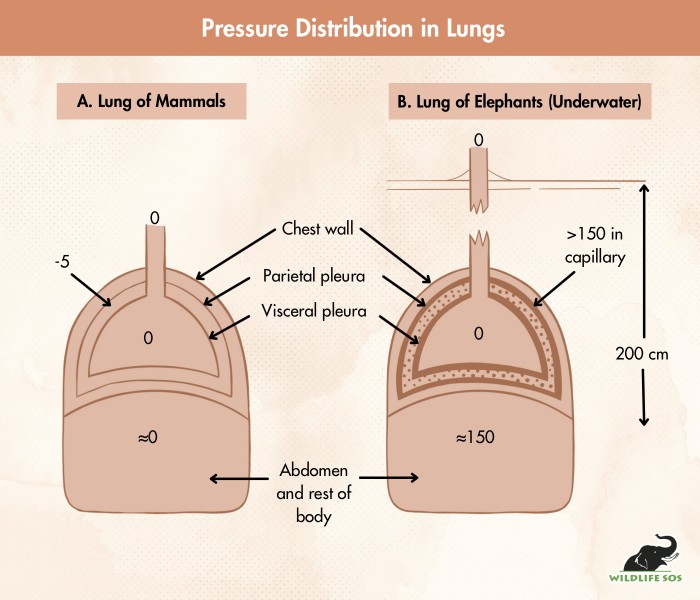
However, when exposed to high pressure while snorkelling at great depths, the microvessels are susceptible to rupture. The amount of transudate leaving the microvessels are bound to increase dramatically as well due to severe imbalance in Starling forces. Starling forces are the physical forces that regulate fluid movement between capillaries and surrounding tissues. When these forces are disrupted, excessive fluid can enter the pleural space, which would make breathing under high pressure extremely difficult, if not impossible, for most mammals.
Evolution’s Solution for Elephants
The risk of damage to the delicate blood vessels and excessive fluid buildup make the pleural membranes the most vulnerable tissues when snorkelling at great depths. But elephants are exempted from such life-threatening risks. To allow pachyderms to safely snorkel while fully submerged in water, the fluid-filled space between pleural membranes is replaced by a loose connective tissue that allows movement, and the pleural membranes themselves are replaced by dense connective tissue, which offers the large mammals protection from any pressure-related damage.
This dense connective tissue that makes up the pleura of elephants is up to 500 μm (micrometres) thick—much more robust than the membrane found in other mammals like sheep, which is 30 μm thin. The connective tissue of elephants lacks microvessels, meaning there is no risk of blood vessel rupture or excess transudate that could occur under high pressure. Even if microvessels were present, they would be well-protected by the dense connective tissue, preventing conditions like oedema from developing.
A layer of loose connective tissue lies between the dense connective tissue of elephants, and performs the same function as what a pleural space would in other mammals. It allows for the sliding movement to take place between the two layers of pleura, without the requirement of pleural fluid.
The Usage of Unique Lungs
Elephants are the only mammals with their pleural cavity obliterated. This adaptation not only enables them to snorkel at great depths, but studies suggest that it also protects their lungs from spontaneous pneumothorax—a condition where air accumulates between the lung and chest wall, causing the lung to partially or completely collapse when they raise water through their trunks to drink or wash.
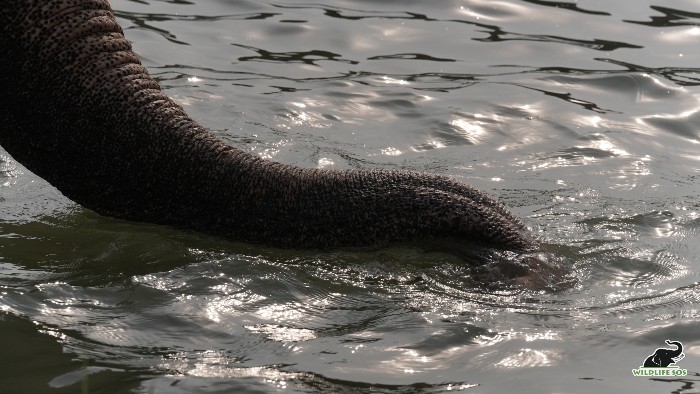
When an elephant sucks water into its trunk, the pressure changes experienced in their lungs are similar to when they are under water. The pressure within the lungs drops below the atmospheric pressure. Interestingly, elephants keep their mouths open during this process, indicating that the low pressure is not generated by their buccal or mouth muscles, as it would in other animals. This suggests that the act of drawing water through their trunks created additional evolutionary pressure, contributing to the development of their unique pleural anatomy. This adaptation ensures that their lungs remain protected despite the significant pressure changes involved.
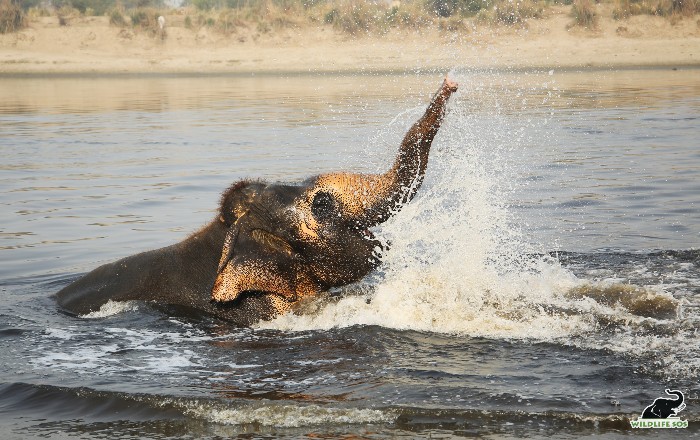
While taking in water into the trunk takes just a few seconds, elephants are able to spend many minutes snorkelling. Their ability to do so can be traced back to an aquatic phase in elephant evolution, where the trunk evolved to function as a snorkel, providing significant survival advantages in water. There is evidence suggesting that elephants (order Proboscidea) share a common ancestor with order Sirenia, an aquatic group that includes dugongs and manatees. This shared ancestry, known as Tethytheria, points to a deep evolutionary connection between these land and sea-dwelling mammals.
If you’re curious to know more about wildlife, consider subscribing to our newsletter!

